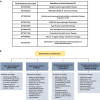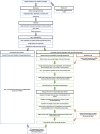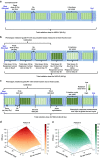Radiation therapy with phenotypic medicine: towards N-of-1 personalization
- PMID: 38514762
- PMCID: PMC11231338
- DOI: 10.1038/s41416-024-02653-3
Radiation therapy with phenotypic medicine: towards N-of-1 personalization
Abstract
In current clinical practice, radiotherapy (RT) is prescribed as a pre-determined total dose divided over daily doses (fractions) given over several weeks. The treatment response is typically assessed months after the end of RT. However, the conventional one-dose-fits-all strategy may not achieve the desired outcome, owing to patient and tumor heterogeneity. Therefore, a treatment strategy that allows for RT dose personalization based on each individual response is preferred. Multiple strategies have been adopted to address this challenge. As an alternative to current known strategies, artificial intelligence (AI)-derived mechanism-independent small data phenotypic medicine (PM) platforms may be utilized for N-of-1 RT personalization. Unlike existing big data approaches, PM does not engage in model refining, training, and validation, and guides treatment by utilizing prospectively collected patient's own small datasets. With PM, clinicians may guide patients' RT dose recommendations using their responses in real-time and potentially avoid over-treatment in good responders and under-treatment in poor responders. In this paper, we discuss the potential of engaging PM to guide clinicians on upfront dose selections and ongoing adaptations during RT, as well as considerations and limitations for implementation. For practicing oncologists, clinical trialists, and researchers, PM can either be implemented as a standalone strategy or in complement with other existing RT personalizations. In addition, PM can either be used for monotherapeutic RT personalization, or in combination with other therapeutics (e.g. chemotherapy, targeted therapy). The potential of N-of-1 RT personalization with drugs will also be presented.
© 2024. The Author(s), under exclusive licence to Springer Nature Limited.
Conflict of interest statement
DH, AB, KSK, SBT, ATLT and LWJT are co-inventors of previously filed pending patents on artificial intelligence-based therapy development. DH is a shareholder of KYAN Therapeutics, which has licensed intellectual property pertaining to AI-based oncology drug development. The findings from this study are being made available for public benefit, and no intellectual property rights arising from the work reported here are being pursued. The remaining authors declare no competing interests.
Figures



References
-
- Ball D, Mai G, Vinod S, Babington S, Ruben J, Kron T, et al. Stereotactic ablative radiotherapy versus standard radiotherapy in stage 1 non-small-cell lung cancer (TROG 09.02 CHISEL): a phase 3, open-label, randomised controlled trial. Lancet Oncol. 2019;20:494–503. doi: 10.1016/S1470-2045(18)30896-9. - DOI - PubMed
Publication types
MeSH terms
Grants and funding
LinkOut - more resources
Full Text Sources
Other Literature Sources
Medical
Research Materials

